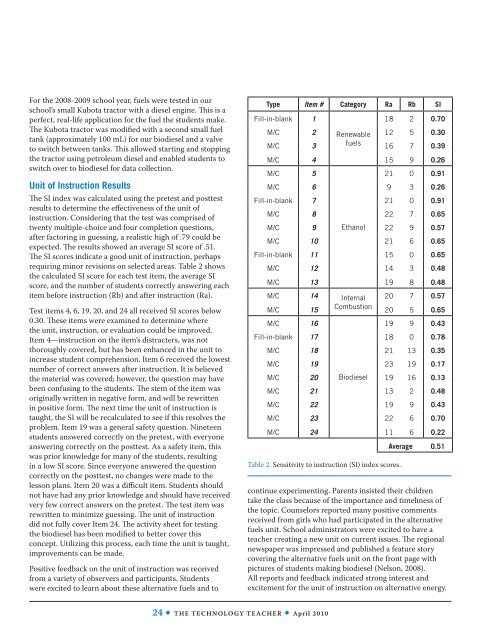Medical Technology: organ harvesting and Transplants
Medical Technology: organ harvesting and Transplants
Medical Technology: organ harvesting and Transplants
Create successful ePaper yourself
Turn your PDF publications into a flip-book with our unique Google optimized e-Paper software.
For the 2008-2009 school year, fuels were tested in our<br />
school’s small Kubota tractor with a diesel engine. This is a<br />
perfect, real-life application for the fuel the students make.<br />
The Kubota tractor was modified with a second small fuel<br />
tank (approximately 100 mL) for our biodiesel <strong>and</strong> a valve<br />
to switch between tanks. This allowed starting <strong>and</strong> stopping<br />
the tractor using petroleum diesel <strong>and</strong> enabled students to<br />
switch over to biodiesel for data collection.<br />
Unit of Instruction Results<br />
The SI index was calculated using the pretest <strong>and</strong> posttest<br />
results to determine the effectiveness of the unit of<br />
instruction. Considering that the test was comprised of<br />
twenty multiple-choice <strong>and</strong> four completion questions,<br />
after factoring in guessing, a realistic high of .79 could be<br />
expected. The results showed an average SI score of .51.<br />
The SI scores indicate a good unit of instruction, perhaps<br />
requiring minor revisions on selected areas. Table 2 shows<br />
the calculated SI score for each test item, the average SI<br />
score, <strong>and</strong> the number of students correctly answering each<br />
item before instruction (Rb) <strong>and</strong> after instruction (Ra).<br />
Test items 4, 6, 19, 20, <strong>and</strong> 24 all received SI scores below<br />
0.30. These items were examined to determine where<br />
the unit, instruction, or evaluation could be improved.<br />
Item 4—instruction on the item’s distracters, was not<br />
thoroughly covered, but has been enhanced in the unit to<br />
increase student comprehension. Item 6 received the lowest<br />
number of correct answers after instruction. It is believed<br />
the material was covered; however, the question may have<br />
been confusing to the students. The stem of the item was<br />
originally written in negative form, <strong>and</strong> will be rewritten<br />
in positive form. The next time the unit of instruction is<br />
taught, the SI will be recalculated to see if this resolves the<br />
problem. Item 19 was a general safety question. Nineteen<br />
students answered correctly on the pretest, with everyone<br />
answering correctly on the posttest. As a safety item, this<br />
was prior knowledge for many of the students, resulting<br />
in a low SI score. Since everyone answered the question<br />
correctly on the posttest, no changes were made to the<br />
lesson plans. Item 20 was a difficult item. Students should<br />
not have had any prior knowledge <strong>and</strong> should have received<br />
very few correct answers on the pretest. The test item was<br />
rewritten to minimize guessing. The unit of instruction<br />
did not fully cover Item 24. The activity sheet for testing<br />
the biodiesel has been modified to better cover this<br />
concept. Utilizing this process, each time the unit is taught,<br />
improvements can be made.<br />
Positive feedback on the unit of instruction was received<br />
from a variety of observers <strong>and</strong> participants. Students<br />
were excited to learn about these alternative fuels <strong>and</strong> to<br />
Type Item # Category Ra Rb SI<br />
Fill-in-blank 1<br />
18 2 0.70<br />
M/C 2 Renewable 12 5 0.30<br />
M/C 3 fuels 16 7 0.39<br />
M/C 4 15 9 0.26<br />
M/C 5<br />
21 0 0.91<br />
M/C 6 9 3 0.26<br />
Fill-in-blank 7 21 0 0.91<br />
M/C 8 22 7 0.65<br />
M/C 9 Ethanol 22 9 0.57<br />
M/C 10 21 6 0.65<br />
Fill-in-blank 11 15 0 0.65<br />
M/C 12 14 3 0.48<br />
M/C 13 19 8 0.48<br />
M/C 14 Internal 20 7 0.57<br />
M/C 15<br />
Combustion<br />
20 5 0.65<br />
M/C 16<br />
19 9 0.43<br />
Fill-in-blank 17 18 0 0.78<br />
M/C 18 21 13 0.35<br />
M/C 19 23 19 0.17<br />
M/C 20 Biodiesel 19 16 0.13<br />
M/C 21 13 2 0.48<br />
M/C 22 19 9 0.43<br />
M/C 23 22 6 0.70<br />
M/C 24 11 6 0.22<br />
Table 2. Sensitivity to instruction (SI) index scores.<br />
Average 0.51<br />
continue experimenting. Parents insisted their children<br />
take the class because of the importance <strong>and</strong> timeliness of<br />
the topic. Counselors reported many positive comments<br />
received from girls who had participated in the alternative<br />
fuels unit. School administrators were excited to have a<br />
teacher creating a new unit on current issues. The regional<br />
newspaper was impressed <strong>and</strong> published a feature story<br />
covering the alternative fuels unit on the front page with<br />
pictures of students making biodiesel (Nelson, 2008).<br />
All reports <strong>and</strong> feedback indicated strong interest <strong>and</strong><br />
excitement for the unit of instruction on alternative energy.<br />
24 • The <strong>Technology</strong> Teacher • April 2010

















